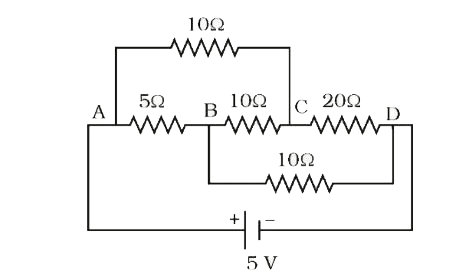A battery of 1.5V may be connected across the point A and B as shown in Fig . What is the current drawn from the battery if the positive terminal of the battery is connected to the point A and the point B. The junction diodes D1 and D2 used are ideal diodes.

When positive terminal of the battery is connected to point A the diode D1 gets forward biased and diode D2 is reverse biased. The diode D1 offer zero resistance and diode D2 offer infinite resistsnce. Now the given circuits will be reduced to the circuit shown in Fig.

Current drawn from the battery,
I=1.5V20Ω=0.075A
When positive terminal of the battery is connected to point B, the diode D2 gets forward biased and diode D1 gets reverse biased. Now the diode D1 will offer infinite resistance and diode D2 will offer zero resistance. The equivalent circuit will be as shown in Fig. 9.39. Current drawn from
the battery, I=1.5V40Ω=0.0375A
Topper's Solved these Questions
- ELECTRONIC DEVICESBook:PRADEEPChapter:ELECTRONIC DEVICESExercise:SAMPLE PROBLEM
Explore 2 Videos
- ELECTRONIC DEVICESBook:PRADEEPChapter:ELECTRONIC DEVICESExercise:CONCEPTUAL PROBLEMS
Explore 1 Video
- ELECTROMAGNETIC WAVESBook:PRADEEPChapter:ELECTROMAGNETIC WAVESExercise:II Focus multiple choice question
Explore 5 Videos
- ELECTROSTATICSBook:PRADEEPChapter:ELECTROSTATICSExercise:ASSERTION-REASON TYPE QUESTIONS
Explore 2 Videos
Similar Questions
A 3V battery may be connected across the point A and B as shown in Fig. Assume that the resistance of each diode is zero in the forward bias and infinity in the reverse bias. Find the current supplied by the battery if the positive terminal of the battery is connected to the point A the point B.
View SolutionCalculate the value of the current drawn from a 5V battery in the circuit as shown

View Solution
Knowledge Check
A 5V battery is connected across the points X and Y. Assume D, and D2 to be normal silicon diodes. Find the current supplied by the battery if the +ve terminal of the battery is connected to point X
 A~0.5AB~1.5AC~0.86AD~0.43A
A~0.5AB~1.5AC~0.86AD~0.43ATwo ideal diodes are connected to a battery as shown in the circuit. The current supplied by the battery is
 A0.5AB0.75ACzeroD0.25A
A0.5AB0.75ACzeroD0.25ATwo ideal diodes are connected to a battery as shown in the circuit. The current supplied by the battery is
 A0.75AB0C0.25AD0.5A
A0.75AB0C0.25AD0.5A
A storage battery is to be charged from a D.C. supply. Should the positive or the negative terminal of the battery be connected to the positive side of the line? Explain.
View SolutionTwo ideal diodes are connected to a battery as shown in the circuit. The current supplied by the battery is

View SolutionA zener diode of 30V is connected as shown with 90V battery as shown in figure. Calculate the current passing through the diode.

View SolutionAn ideal battery of emf 12 V is connected across an electric network shown here.

Now answer the following questions:
Net current drawn by the circuit from the battery is:
View SolutionTwo ideal junction diodes D1,D2 are connected as shown in the figure. A 3V battery is connected between A and B. The current supplied by the battery if its positive terminal is connected to A is
 .
.
View Solution

